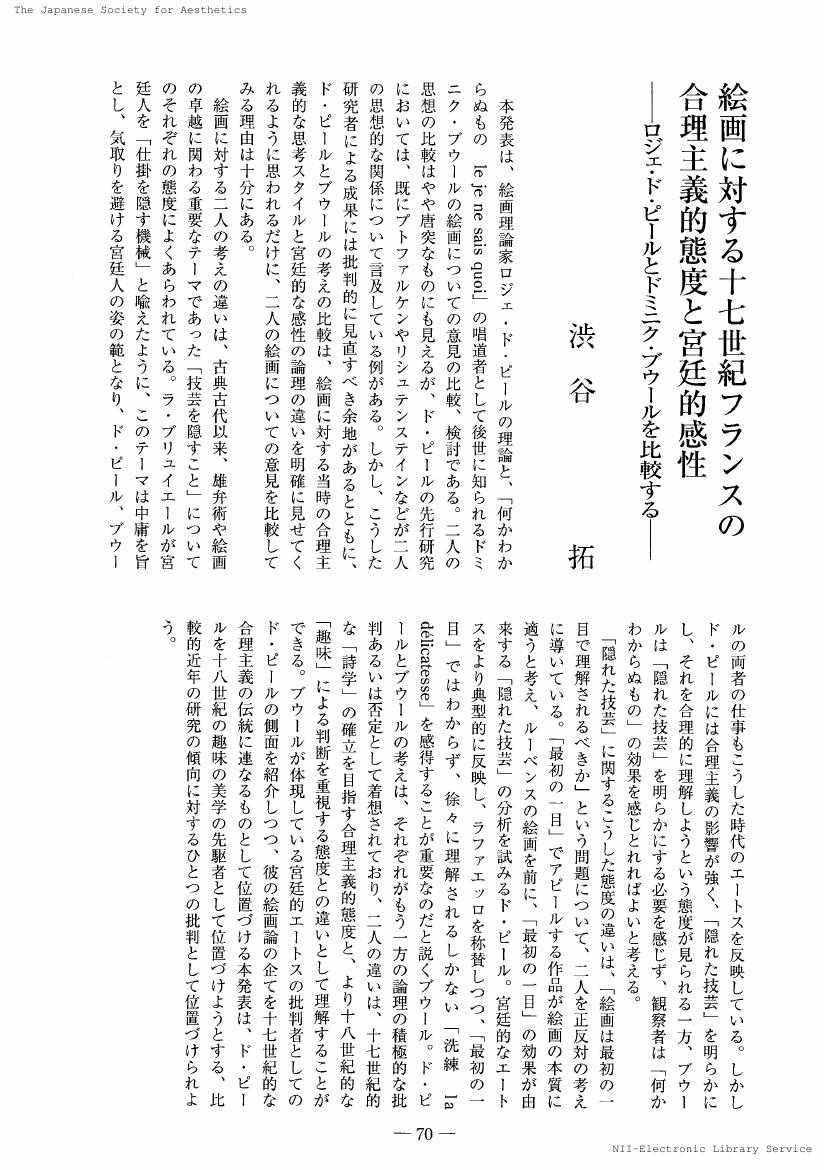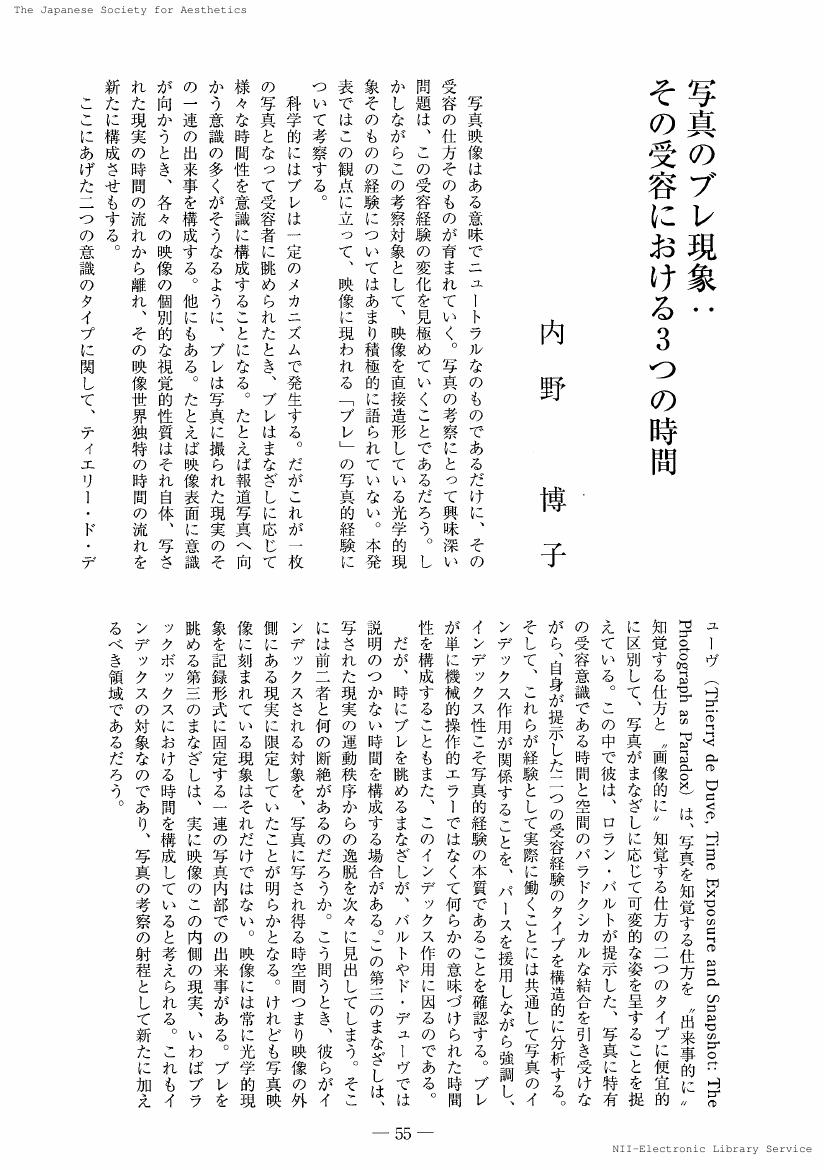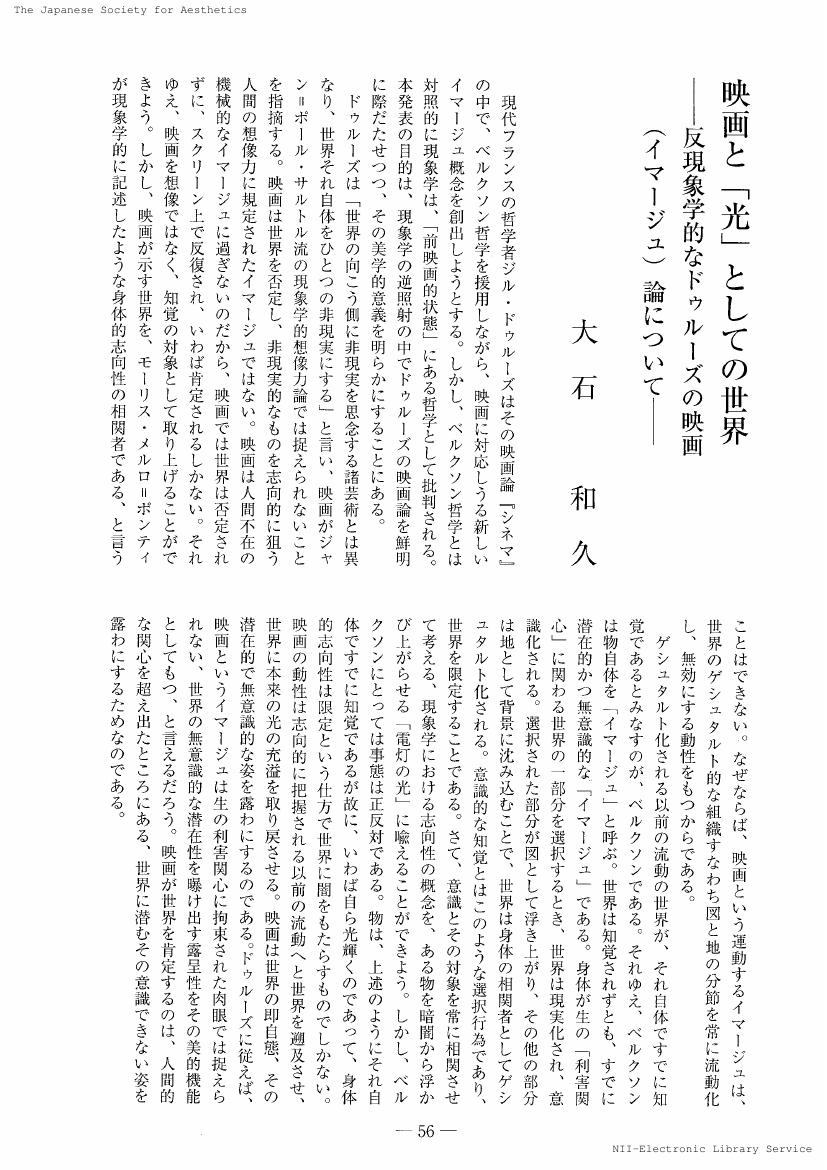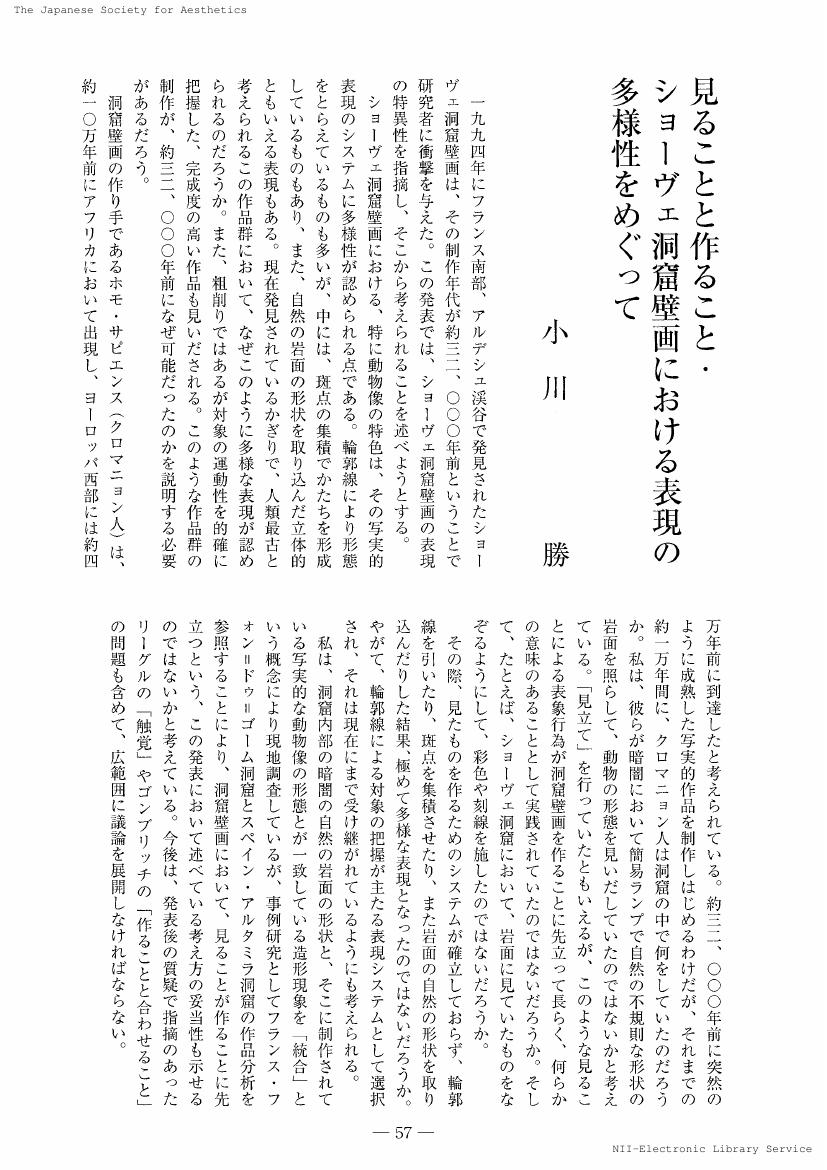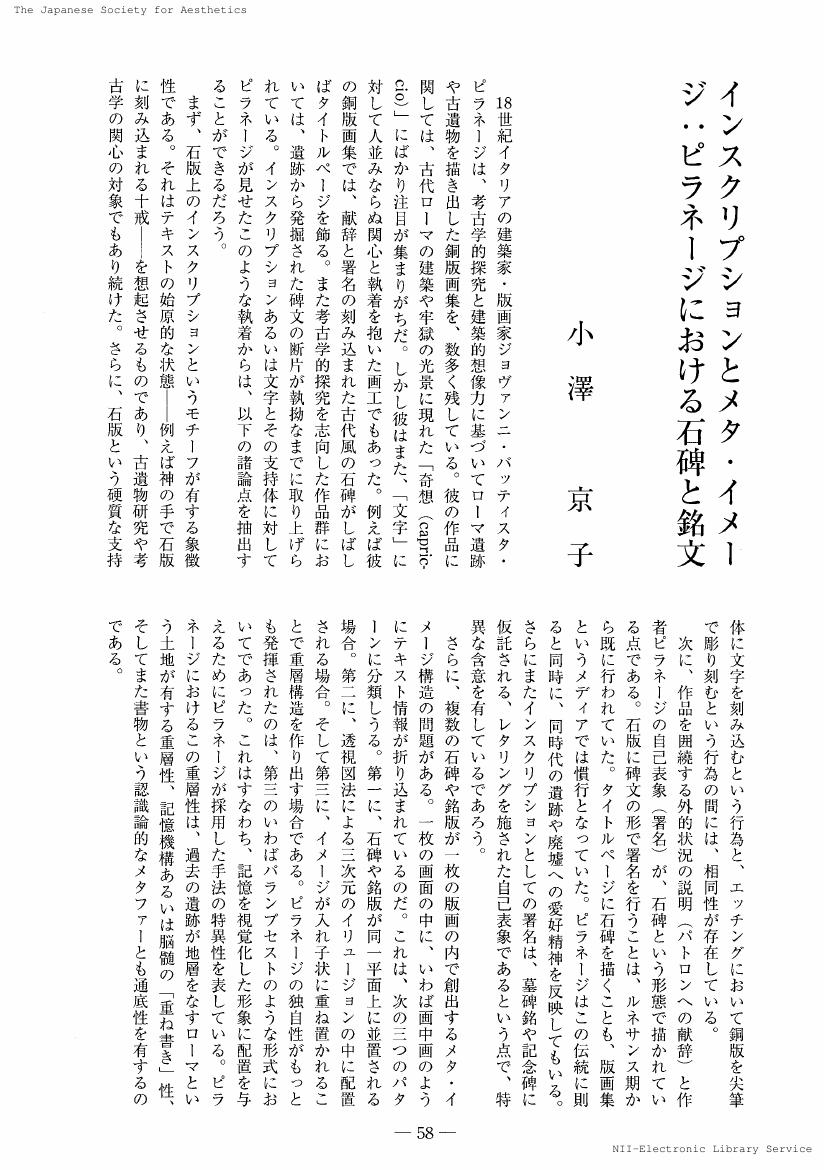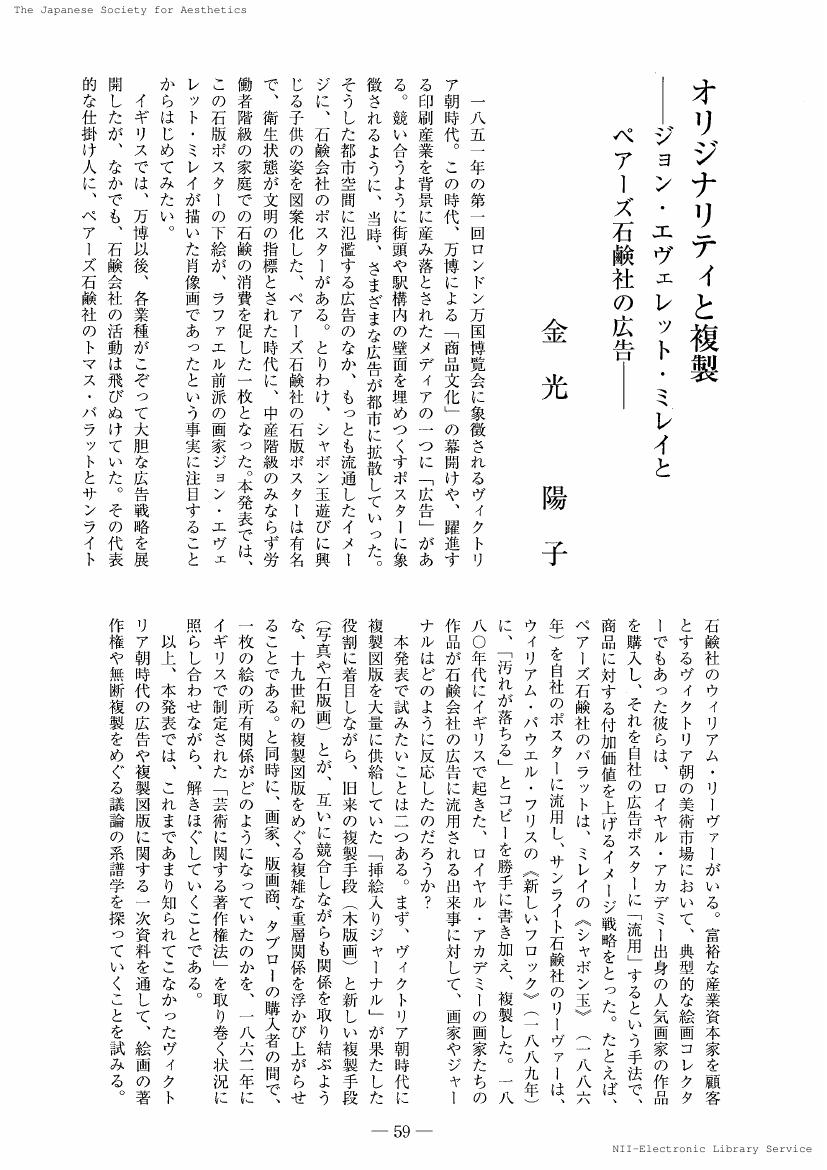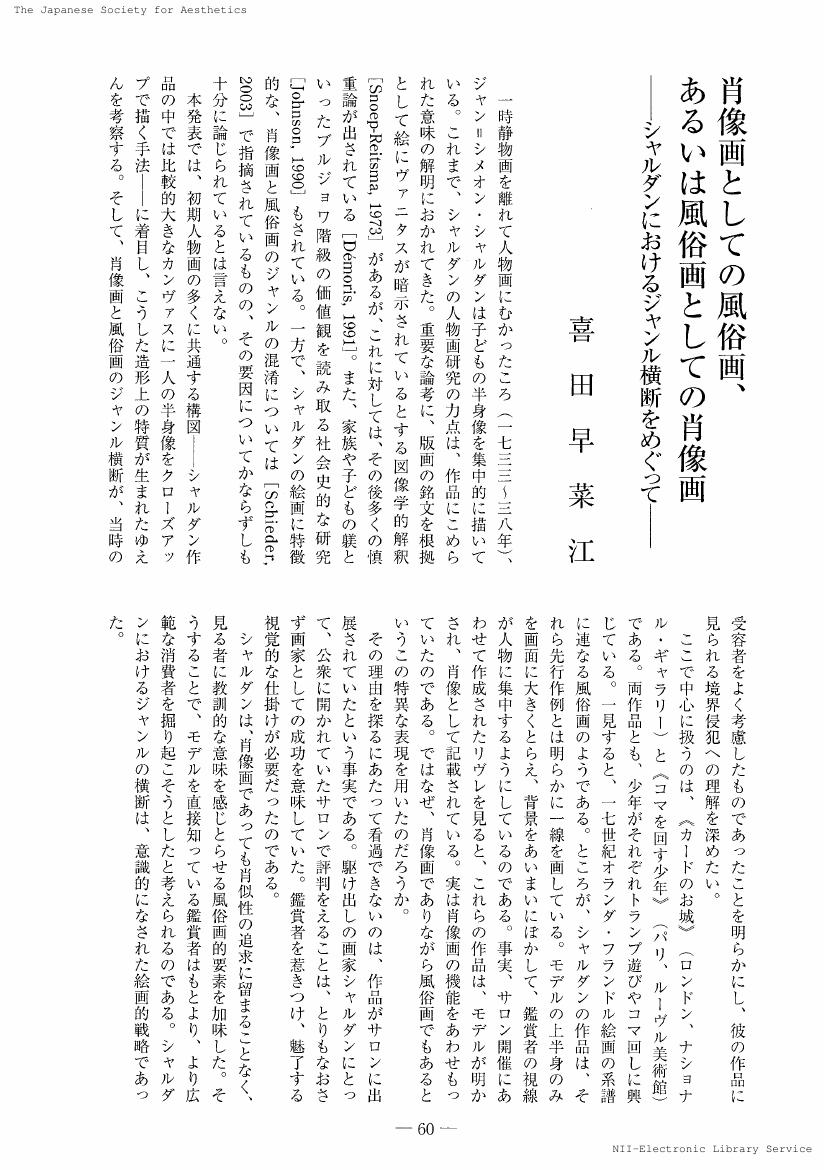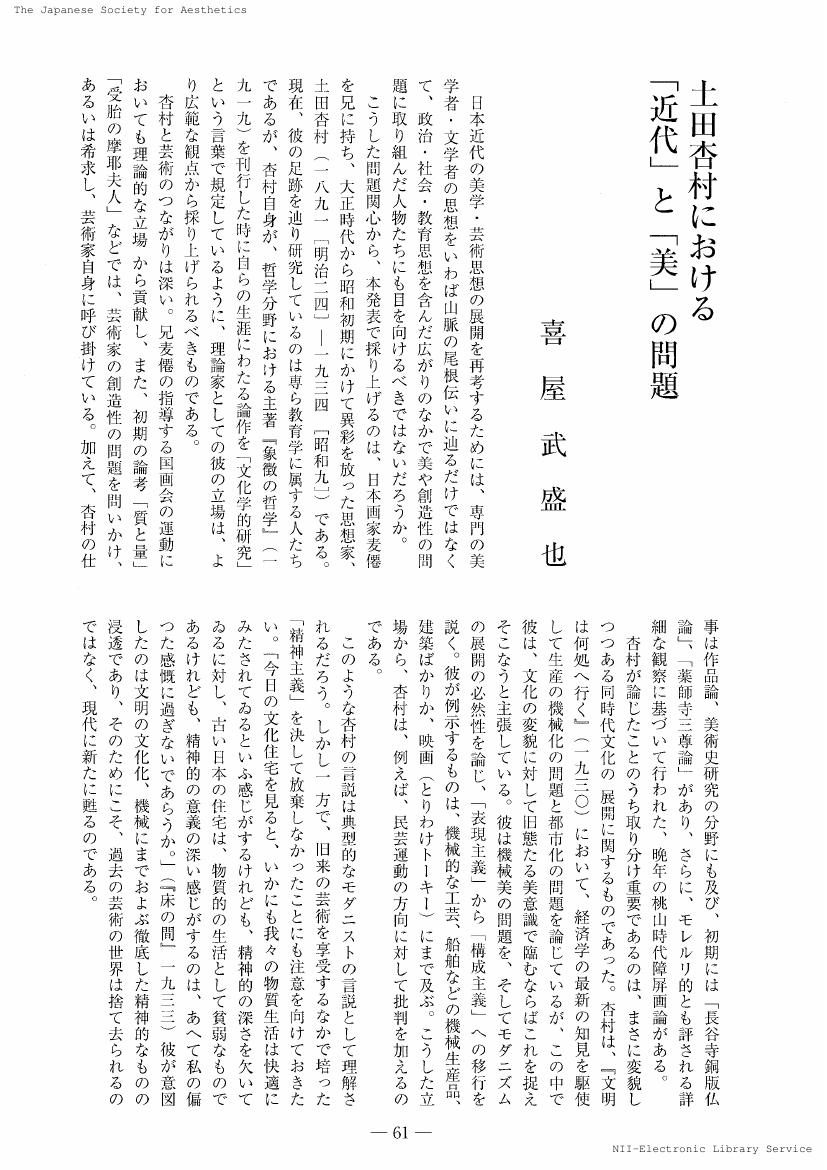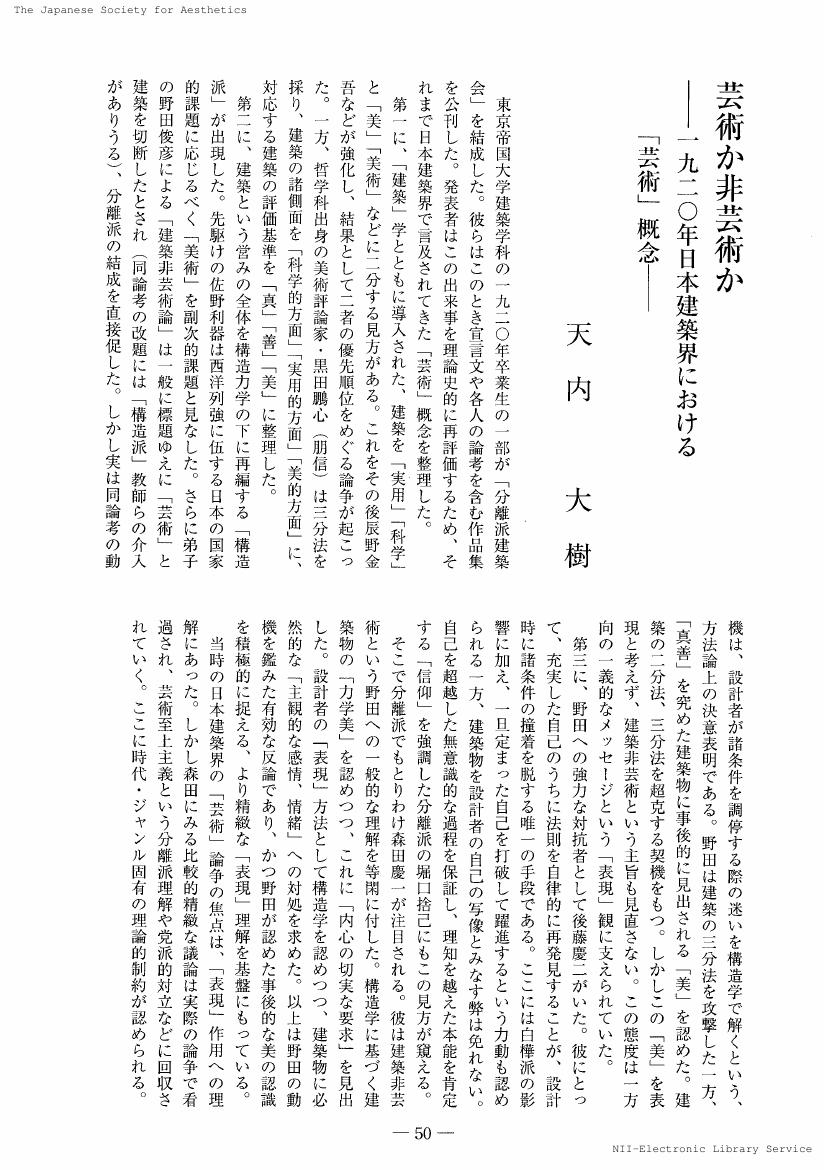- 著者
- 渋谷 拓
- 出版者
- 美学会
- 雑誌
- 美学 (ISSN:05200962)
- 巻号頁・発行日
- vol.56, no.3, pp.70, 2005-12-31 (Released:2017-05-22)
- 著者
- 一條 和彦
- 出版者
- 美学会
- 雑誌
- 美学 (ISSN:05200962)
- 巻号頁・発行日
- vol.56, no.3, pp.52, 2005-12-31 (Released:2017-05-22)
- 著者
- 入江 繁樹
- 出版者
- 美学会
- 雑誌
- 美学 (ISSN:05200962)
- 巻号頁・発行日
- vol.56, no.3, pp.53, 2005-12-31 (Released:2017-05-22)
- 著者
- 植田 彩芳子
- 出版者
- 美学会
- 雑誌
- 美学 (ISSN:05200962)
- 巻号頁・発行日
- vol.56, no.3, pp.54, 2005-12-31 (Released:2017-05-22)
1 0 0 0 OA 写真のプレ現象 : その受容における3つの時間(第五十六回美学会全国大会発表要旨)
- 著者
- 内野 博子
- 出版者
- 美学会
- 雑誌
- 美学 (ISSN:05200962)
- 巻号頁・発行日
- vol.56, no.3, pp.55, 2005-12-31 (Released:2017-05-22)
- 著者
- 大石 和久
- 出版者
- 美学会
- 雑誌
- 美学 (ISSN:05200962)
- 巻号頁・発行日
- vol.56, no.3, pp.56, 2005-12-31 (Released:2017-05-22)
- 著者
- 小川 勝
- 出版者
- 美学会
- 雑誌
- 美学 (ISSN:05200962)
- 巻号頁・発行日
- vol.56, no.3, pp.57, 2005-12-31 (Released:2017-05-22)
- 著者
- 小澤 京子
- 出版者
- 美学会
- 雑誌
- 美学 (ISSN:05200962)
- 巻号頁・発行日
- vol.56, no.3, pp.58, 2005-12-31 (Released:2017-05-22)
- 著者
- 金光 陽子
- 出版者
- 美学会
- 雑誌
- 美学 (ISSN:05200962)
- 巻号頁・発行日
- vol.56, no.3, pp.59, 2005-12-31 (Released:2017-05-22)
- 著者
- 喜田 早菜江
- 出版者
- 美学会
- 雑誌
- 美学 (ISSN:05200962)
- 巻号頁・発行日
- vol.56, no.3, pp.60, 2005-12-31 (Released:2017-05-22)
1 0 0 0 OA 土田杏村における「近代」と「美」の問題(第五十六回美学会全国大会発表要旨)
- 著者
- 喜屋武 盛也
- 出版者
- 美学会
- 雑誌
- 美学 (ISSN:05200962)
- 巻号頁・発行日
- vol.56, no.3, pp.61, 2005-12-31 (Released:2017-05-22)
1 0 0 0 OA バレエにおけるtempsの概念
- 著者
- 譲原 晶子
- 出版者
- 美学会
- 雑誌
- 美学 (ISSN:05200962)
- 巻号頁・発行日
- vol.56, no.2, pp.55-68, 2005-09-30 (Released:2017-05-22)
The concept 'temps' as ballet terminology was born with the birth of danse classique in the 17th century, following the concept of the same term established in the music theory in the same period. The term, which denotes a unit of dance movement basically, had been re-defined repeatedly through ballet history, especially in relation to the concept 'pas'. However, in current ballet theories traditional ideas of 'temps' seem to have disappeared, and the term can be seen only in names of some ballet steps. Why did the concept emerge in the ballet, how was it understood in the different periods of the ballet history and why did it become unused? To answer these questions I, at first, traced the original idea of this term in the music. Then I examined the various definitions of 'temps' and usages of this term found in main dance books since the 17th century. Viewing over transformations of ballet steps under the influence of the concept 'temps' through ballet history, it can be noticed that, though the concept is no more used in the theory today, it remains alive practically in actual ballet movements.
1 0 0 0 OA バロック音楽の演奏習慣に、舞踏身体のリズム特性を読む : 不等音符奏法の場合
- 著者
- 赤塚 健太郎
- 出版者
- 美学会
- 雑誌
- 美学 (ISSN:05200962)
- 巻号頁・発行日
- vol.56, no.2, pp.69-82, 2005-09-30 (Released:2017-05-22)
In the baroque period, the body of French courtiers was educated in dance lessons. Therefore the most basic motion in the dance of that time, which was called mouvement, dominated rhythmic character of their bodies. Mouvement is a bending of the knees followed by a rise of the body and a straightening of the knees. The energy of the rise from the sink stresses the measure, but these motions are executed quite fluently and have no instant that divide time into beats. Because of these characters, the dancer count beats upward. Music has to cooperate with this bodily feeling in some ways, and notes inegales is one of them. Notes inegales is a convention in which notes with equal written values are performed with alternation of long and short durations. This convention has some characters in common with mouvement. For example, it conceals gaps between beats and makes the performance more graceful. Still more, the duration of the sound has great importance under this convention. Experience of this duration requires concentration on the progress of the sound. Here it builds up the mutual relationship with the rhythmic character of the body.
1 0 0 0 OA ニーチェにおける<幻視>の概念 : 芸術経験における視覚と身体
- 著者
- 河合 大介
- 出版者
- 美学会
- 雑誌
- 美学 (ISSN:05200962)
- 巻号頁・発行日
- vol.56, no.3, pp.1-14, 2005-12-31 (Released:2017-05-22)
After the "Death of Painting," the role of vision in the experience of art has changed entirely. The privilege of visuality in modernism has been superseded by a minimalist visuality, which contains in itself the relation between the beholder and the work. In this light, Nietzsche's concept of Vision (the German word meaning "vision" or "hallucination") assumes a different aspect. In The Birth of Tragedy, Apollonian art is attributed to the dream in which we look away from sufferings in real life, and become absorbed in contemplation of an imaginary world. In tragedy, however, the Apollonian operation is called Vision in distinction from the dream. The intoxicated spectator transfigures actors on the stage into gods and acquires an insight into the Dionysian origin of the world. In his later work Twilight of the Idols, in which Vision as an intoxication of the eye replaces the dream, Apollonian art as well as music arouses intoxication. A transfiguration results from this, with the eyes open. Therefore, Vision is a sort of visuality that exists as a physical relation between the beholder and the work. This concept of Vision provides a new perspective on both Nietzsche's theory of art and contemporary art.
- 著者
- 島田 有紀
- 出版者
- 美学会
- 雑誌
- 美学 (ISSN:05200962)
- 巻号頁・発行日
- vol.56, no.3, pp.15-28, 2005-12-31 (Released:2017-05-22)
The standing screens on the title is the oldest work extant of KANO Motonobu's work as folding screens of thick colored flowers and birds with golden background. This thesis designates that the scenery and the motif of the work are in correspondence with both descriptions of the scenery of Pure Land in several Buddhist scriptures and the design of actual gardens. Firstly, a peacock on the right hand screen is focused to indicate the bird connotes the elements of auspicious birds in Buddhism, such as Mahamayuri and Kalavinka. Secondly, the elements of the scenery in the work, such as the four seasons at the same time - the depiction of perpetuity - and the existence of a pond, are identified with the description of Pure Land in Kwan-mu-liang-shou-ching and Ta-wuliang-shou-ching. These elements of the garden in the work are placed similarly to the Pure Land style gardens, which are illustrated in "Center and Surrounds of Kyoto" (Rakuchu-rakugai Zu)'s. In consideration of the above factors, the conclusion that, in the work, KANO Motonobu succeeded to portray the ideal garden by combining the scenery of Pure Land and that of actual gardens, is drawn.
1 0 0 0 OA イメージの領域 : シュルレアリスムにおけるイヴ・タンギーの特殊性
- 著者
- 長尾 天
- 出版者
- 美学会
- 雑誌
- 美学 (ISSN:05200962)
- 巻号頁・発行日
- vol.56, no.3, pp.29-42, 2005-12-31 (Released:2017-05-22)
Yves Tanguy (1900-1955) is one of the most important painters of surrealism. His unique image, however, has never been concretely discussed. The purpose of this paper is to show the characteristic of Tanguy's image in surrealist contexts and to add a new aspect to the discussions about optical images of surrealism. According to Roger Caillois, surrealist image is "an image without assured, perceptible or unitary signification," and has an "infinite" structure which makes viewer's interpretations infinitely. This paper calls this kind of image an "obscure image." Most surrealist images are constructed by signs that have a defined and perceptible signifie, and these signs make gaps of meaning among each other to become an "obscure image" (the principle of "depaysement"). However, in Tanguy's image, signs that form his image do not have a defined and perceptible signifie. Moreover, that image is the perfect representation with three-dimensional illusion. For this reason, the viewer's interpretations caused by "infinite" structure are all nullified. The image of Tanguy is an image that could be resolved into nothing except for image itself. That is an extreme form of the surrealist image.
- 著者
- 天内 大樹
- 出版者
- 美学会
- 雑誌
- 美学 (ISSN:05200962)
- 巻号頁・発行日
- vol.56, no.3, pp.50, 2005-12-31 (Released:2017-05-22)
- 著者
- 池上 健一郎
- 出版者
- 美学会
- 雑誌
- 美学 (ISSN:05200962)
- 巻号頁・発行日
- vol.56, no.3, pp.51, 2005-12-31 (Released:2017-05-22)
1 0 0 0 OA 『パルマ福音書』の「マイエスタス・ドミニ」における福音書記者
- 著者
- 桜井 夕里子
- 出版者
- 美学会
- 雑誌
- 美学 (ISSN:05200962)
- 巻号頁・発行日
- vol.56, no.1, pp.28-40, 2005-06-30 (Released:2017-05-22)
The Parma Gospel Book (Parma, Palatine Library cod. 5) is one of the well-known Tetraevangelia in Byzantine manuscripts, produced in Constantinople in the latter half the llth century. The main subject of this article is the layout of the Evangelists of "Maiestas Domini" (f.5r), the frontispiece for the four Gospels. From the above-left, clockwise, Mark, Matthew, John, Luke are situated. Below the framed picture, Peter, Paul, John the Theologian, and the emperor Trajan are flanked by the title of the Hypothesis. Being referred in the texts of the Hypothesis, they are placed under the related Evangelists. The point is that why not Matthew but Mark is situated at the beginning, contrary to the Gospel order. It is concluded that the painter can give Peter the top position by this replacement of Matthew to Mark. The emphasis on Peter is also found in the illustrations of the Life of Christ (ff. 91v-92v). The miniatures are placed at the beginning of Mark's Gospel, "dictated by Peter," for the emphasis on Peter.
1 0 0 0 OA ヒッチコック『恐喝』をめぐって : 音と映像によるサスペンスの諸相
- 著者
- 碓井 みちこ
- 出版者
- 美学会
- 雑誌
- 美学 (ISSN:05200962)
- 巻号頁・発行日
- vol.56, no.1, pp.55-68, 2005-06-30 (Released:2017-05-22)
This article deals with Alfred Hitchcock's Blackmail (1929) from the point of view of suspense and its exploration of cinematic sound and image. Blackmail has been regarded just as an experimental work of sound. Yet, we should rethink the use of suspense in Blackmail because the association between sound and image brings pressure more directly on the audience to experience uncertainty and anxiety. In a suspense plot, the audience identifies him/herself with characters, who are anxious about their fate and are bearing their misfortunes. In addition, we can find another pattern of suspense, in which the audience no longer empathizes with the characters per se. This suspense's real target of attack is the audience. Although in Blackmail we empathize with the heroine and her boyfriend, it nevertheless evokes our own anxiety rather than our empathy with characters. For example, the voice "knife, knife..." enormously compresses the heroine's anxiety and tears into the visual/aural representation of her ordinary life. This "knife" scene strongly intensifies our own anxiety rather than our empathy with her. In addition, the similar example of suspense is the use of the inaudible voice and invisible face of her boyfriend in a phone booth. This scene allows us to project our own expectations of what will be going on in the future scenario. We do not think that Hitchcock's narrative explanation is a limit of his film's abilities. Rather, his use of suspense expands the possibilities of cinematic representation and significantly changes the audience's alliance to the world of film.
